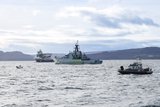Turkish firm launches new family of UUVs
An artist’s impression of the STM NETA 300 at work. (Image credit: STM)
STM launched a new uncrewed autonomous underwater vehicle (UUV), known as the “NETA 300”, at Saha Expo in Istanbul this week.
Devised principally as a mine-detection vessel, the NETA 300 was pitched as having both a military and civilian use case, which will open up multiple sales channels for the vessel. Built on modular principles with a flexible design that allows its deployment on a wide range of missions, the 300 version was launched as only the first in what STM called “a family of platforms” in the UUV sphere. It will be of most immediate use in shallow waters, up to 300 metres, and having been announced, has now moved on to its pool and sea testing phases.
While designed primarily as a military mine-detector and disposal vessel, at launch, STM said it could be effective in a range of roles, “from intelligence, surveillance and reconnaissance, to anti-submarine warfare, explosive disposal, and pipeline and geophysical surveys”.
Related Articles
Turkey’s first commercial-built special operations submarine passes pressure hull test
Then the plan is to develop medium-sized and larger unmanned underwater vehicles that can operate at greater depths and on different, longer-term missions. It is in this notion of a full family of UUVs that STM sees the NETA family’s potential export value among what it calls “friendly and allied nations”.
At launch, the NETA 300 had a maximum speed of 5 knots and a maximum operating life of 24 hours on a single battery charge. Larger UUVs would be able to carry sturdier batteries for longer operating lives between charges. The UUV can operate autonomously when deployed on mine countermeasure missions, using side-scan and gap-filling sonar technologies to identify mines in suspected high-risk areas.
STM released no exact timeframe for the growth of the NETA family of UUVs, and the timeline will likely depend on take-up of the initial NETA 300 offering.
More from Naval Warfare
-
![MBDA-led DragonFire’s latest trials move the LDEW system closer to UK Navy integration]()
MBDA-led DragonFire’s latest trials move the LDEW system closer to UK Navy integration
The DragonFire lines up with other European laser-directed energy weapons being developed in collaboration with MBDA.
-
![US Coast Guard pursues solutions to increase maritime domain dominance]()
US Coast Guard pursues solutions to increase maritime domain dominance
The USCG is seeking technologies, services and applications to better connect its assets and speed up the decision-making process.
-
![Canadian Coast Guard’s OOSV delivery is “major milestone” in fleet modernisation]()
Canadian Coast Guard’s OOSV delivery is “major milestone” in fleet modernisation
The Polar Class 6 platform is the largest CCG science-dedicated vessel and will operate on the country’s east coast.
-
![How the Anduril-HHI autonomous ship plan fits in with the US Navy’s MASC programme]()
How the Anduril-HHI autonomous ship plan fits in with the US Navy’s MASC programme
The new modular vessel is expected to be developed for both commercial and defence use, with a heavy focus on production speed and mission flexibility.
-
![Indo Pacific 2025: Autonomous systems reigned but can the Australian Defence Force afford it?]()
Indo Pacific 2025: Autonomous systems reigned but can the Australian Defence Force afford it?
Multiple autonomous systems and technologies were on display at this year’s Indo Pacific, but questions remain over how the Australian Department of Defence will balance the books.
























